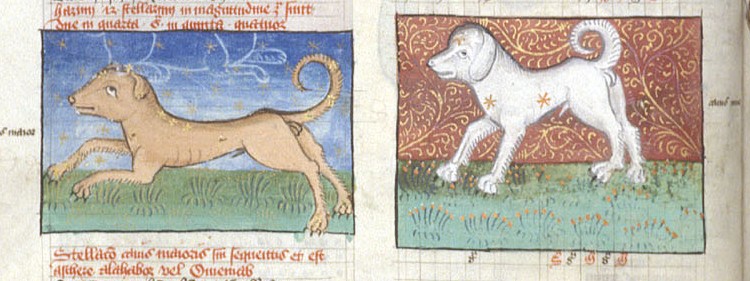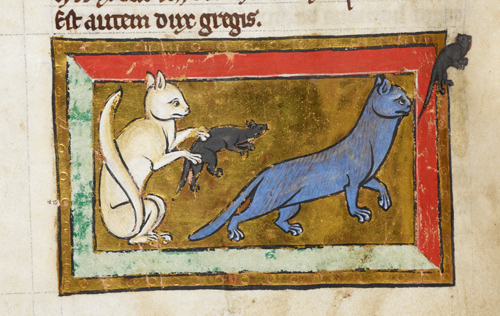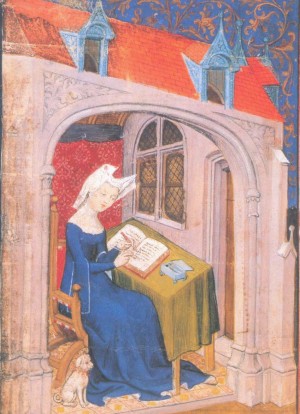Medieval people did have pet dogs, cats and other animals. Here is some of the advice they gave about taking proper care of these animals.
Pets were a rarity in the medieval world – people in the Middle Ages did keep domestic animals like dogs and cats, but most of them served a purpose. Dogs would be used to guard homes or assist in the hunt, while cats were needed to catch mice and other vermin. Still, the relationship between these animals and their keepers was often an affectionate one.
The leading research on this topic can be found in Medieval Pets, by Kathleen Walker-Meikle, who notes that by the end of the Middle Ages we can find many examples of people keeping animals as their companions. The Italian poet Petrarch had several pet dogs, one of which he adopted when it was left at a house he way staying at. Meanwhile, the famous Renaissance woman Isabella d’Este (1474 – 1539) owned several cats, including one named Martino. When it died in 1510, the cat was given a proper burial along with a graveside sermon.
Many of the writings about pets from the later Middle Ages comes in the form of criticism that people should not keep them – that it was too frivolous and a waste of food that could have gone to the poor. Church officials found that monks and especially nuns were keeping dogs, cats and birds as pets – while they could not ban them entirely, they did plead with the monks and nuns not to keep too many and not to take them into church with them. Meanwhile the Ancrene Riwle, a guide for anchoresses, explains:
Unless need compels you, my dear sisters, and your director advises it, you must not keep any animal except a cat…Now if someone needs to keep one, let her see to it that it does not annoy anyone or do any harm to anybody, and that her thoughts are not taken up with it.

Miniatures of Canis Maior (Larger Dog) and Canis Minor (Smaller Dog), in tables from Ptolemy’s Almagest.
The 13th century scientist and philosopher Albertus Magnus wrote a book On Animals that details the characteristics of various creatures, and includes some helpful advice on their care. Dogs, for example, should not be fed the food right off the dinner plate or be petted constantly, if you want them to be effective guard dogs. Otherwise, these canines will “keep one eye on the door and one on the generous hand of the master.” Meanwhile, the cat “loves to be lightly stroked by human hands and is playful, especially when it is young.” Albertus advises that you should clip the ears of the felines so that night dew does not get into its ears , and that if you cut off the whiskers around their mouth “they lose their boldness.”
At the end of the 14th century Gaston III, Comte de Foix (1331-1391) wrote a book about hunting called Livre de Chasse, which included a section on how he took care of the greyhounds he used in the hunt. Gaston explains that their kennels should be built of wood and at least a foot off the ground, with loft where the dog could be cool in the summer and warm in the winter. It should also have fresh straw added to its floor each day and have a door that opens into a sunny yard, so that “the houndes may go withoute to play when them liketh for it is grete likyng for the houndes whan thei may goon in and out at their lust.”
The servant in charge of the dogs would be kept very busy – they were to clean the kennels each morning and give fresh water twice a day. The hounds also needed to be taken out once or twice daily for walks and allowed to play “in a fair medow in the sun.” Besides being fed bran bread, the dogs would also get some of the meat from the hunt. If a dog was sick, he would get better food, such as goat’s milk, bean broth, chopped meat, or buttered eggs.
When training these dogs, Gaston explains that you need to reward them for good deeds and punish mistakes, but when talking to them you must always be truthful. He adds, “I speak to my hounds as I would a man…and they understand me and do as I wish better than any other man can make them do as I do, nor peradventure will anyone do it more when I am dead.”
In the Islamic world, dogs were supposedly considered an unclean animal and should not be kept as a pet. That did not keep people from having them, although they were only supposed to be used for hunting, guarding or herding animals, and several books by Arab writers gives advice on how to take care of them. This includes that dogs should sleep close to their handlers (although not in the same bed) as it will make them friendlier, more obedient, and even make them smell more pleasant. The dog should also have a soft bed of their own to lie on, and have them avoid living closely with other dogs, as they can spread disease to the other animals.
During the fall and winter months, dogs should be fed only once a day, around sunset – otherwise the writers believe the dogs will not be fit enough when the hunt begins the next morning. However, during the much hotter spring and summer months, dogs were to be fed small portions several times a day. The food was usually meat soaked in a beef soup, but could also include bread and milk, and would be served tepid or cold so that dogs would not vomit it.
In the work Mamluks and Animals: Veterinary Medicine in Medieval Islam, Housni Alkhateeb Shehada noted that these Islamic writers, “emphasized that the dog is an animal that demands special attention, which includes stroking and combing its fur with pleasant caressing materials such as silk. The authors write that stroking with the hands, scratching, touching and suchlike basic actions that every dog handler has to perform in his daily care of the dog help to ensure the dog’s good health.”
Finally, Walker-Meikle explains that one of the best sources on medieval bird care comes from Le Ménagier de Paris, a guidebook that was written around 1393 by an elderly Parisian merchant for his new wife. In one section he details that caged birds need to have their water constantly replenished and adds:
Item, let carded wool and feathers be put in the aviary to make their nests. And thus have I see turtle-doves, linnets and goldfinches lay and rear their young. Item, you should also give them caterpillars, worms, flies, spiders, grasshoppers, butterflies, fresh hemp in leaf, moistened and soaked. Item, spiders, caterpillars and such like things which be soft to the little bird’s beak, which is tender.
See also Medieval Pet Names
See also: Medieval Pets, by Kathleen Walker-Meikle
Resources
“Good Dog: Model Canines in Renaissance Manuscripts,” by Marina Belozerskaya, Tributes in Honor of James H. Marrow: Studies in Painting and Manuscript Illumination of the Late Middle Ages and Northern Renaissance, eds. J. Hamburger and A. Korteweg (Brepols, 2006)
“The Dogs of Yesteryear,” by Beatrice Johnston, History Today,Vol.29:2 (1979)
Mamluks and Animals: Veterinary Medicine in Medieval Islam, by Housni Alkhateeb Shehada (Brill, 2012)
Medieval Cats, by Kathleen Walker-Meikle (British Library, 2011)
Medieval Dogs, by Kathleen Walker-Meikle (British Library, 2013)
Medieval Pets, by Kathleen Walker-Meikle (Boydell and Brewer, 2012)
















Pentru a putea adăuga comentarii trebuie să fii membru al altmarius !
Alătură-te reţelei altmarius